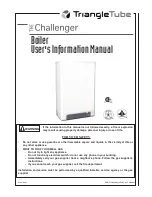
INITIAL START-UP
4-3
NOTE:
On initial start-up, or return to service from a
fault condition, the unit will remain at a 29%
valve position for two-minutes.
9. Following the warm-up period, increase the
valve position in 20% increments while
monitoring the gas pressure after every
increase. If gas pressure dips below 8.8”
W.C. for FM gas trains and 9.2” for IRI gas
trains at any input valve position percentage,
stop and raise the pressure. Once 100% is
reached, adjust the gas pressure for 8.8”
W.C. (FM) or 9.2” W.C. (IRI).
NOTE:
If 8.8” W.C. for FM gas trains or 9.2” W.C. for IRI
gas trains cannot be obtained at the 100% valve
position, it will be necessary to stop calibration
and contact the local AERCO representative in
your area. Running the unit on insufficient gas
pressure will void the warranty.
10. Once 8.8” W.C. or 9.2” W.C. is set at the
100% level, change the valve position to
30%. Insert the combustion analyzer probe
into the stack.
NOTE:
Always approach a valve position percentage
from the same direction, (i.e., 100% to 30%,
30% to 20%, etc.). Whenever going to an
increased valve position from below (i.e., 20%
to 30%), first go above and then back down to
the desired valve position. This is necessary due
to hysteresis in the air/fuel stepper motor.
Hysteresis causes the air/fuel valve to stop in a
slightly different position if the valve position
percentage is approached from below or above.
This results in a difference in oxygen readings
for the same valve position percentage causing
unnecessary recalibration
.
11. Allow enough time for the combustion
analyzer to settle. Compare the measured
oxygen level to the oxygen range for intake
air temperature in Table 1. Also, ensure that
the carbon monoxide (CO) and nitrogen
oxide (NOx) readings do not exceed the
values shown.
12. If the measured oxygen level, CO and NOx
emissions are within the ranges shown in
Table 1, no adjustment is necessary.
Proceed to step 19.
Table 1
Combustion Oxygen Levels for a 30%
Valve Position
Inlet Air
Temp
Oxygen
(±0.2%)
Carbon
Monoxide
*NOx
-25°F
7.8%
<100 ppm
<30 ppm
-10°F
7.5%
<100 ppm
<30 ppm
0°F
7.4%
<100 ppm
<30 ppm
10°F
7.2%
<100 ppm
<30 ppm
25°F
6.9%
<100 ppm
<30 ppm
40°F
6.5%
<100 ppm
<30 ppm
55°F
6.4%
<100 ppm
<30 ppm
70°F
6.2%
<100 ppm
<30 ppm
85°F
5.9%
<100 ppm
<30 ppm
100°F
5.7%
<100 ppm
N/A
* NOx readings corrected to 3% oxygen.
13. If the measured oxygen level is
not
within
the range listed in Table 1, remove the
regulator cap and cap gasket from the
differential pressure regulator (see
Figure 4.3) and proceed to step 14.
DIFFERENTIAL
PRESSURE
REGULATOR
REGULATOR CAP
CAP GASKET
Figure 4.3
Differential Pressure Regulator
14. Use a flat-tip screwdriver to adjust the
differential pressure regulator. Turn the
screwdriver:
•
counterclockwise
to
increase
the
oxygen level
•
clockwise
to
decrease
the oxygen level
Содержание KC Series
Страница 64: ......
Страница 74: ......
Страница 78: ......
Страница 86: ......
Страница 87: ...APPENDIX C Temperature Sensor Resistance Chart Balco ...
Страница 88: ......
Страница 91: ...APPENDIX E E 1 ...
Страница 100: ......
Страница 106: ......
Страница 112: ......
Страница 114: ......
Страница 117: ......
Страница 118: ......
















































